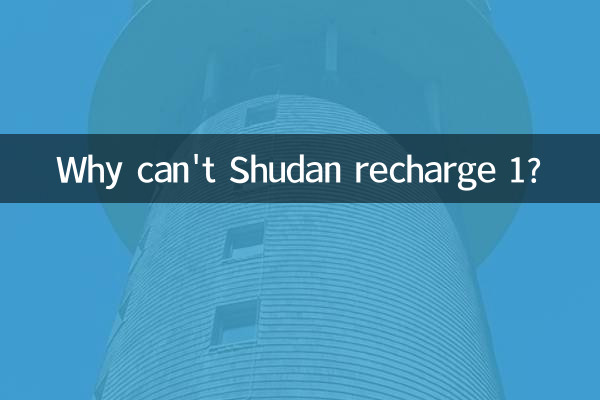Why can't Shudan recharge 1?
In recent years, with the rise of online literature, more and more readers choose to recharge for reading on the platform. However, many users found that the minimum recharge amount on Shudan and other platforms was often higher than 1 yuan, which triggered widespread discussion. This article will analyze the reasons behind this phenomenon based on the hot topics and hot content on the Internet in the past 10 days, and display relevant opinions through structured data.
1. Analysis of hot topics and hot content

The following are the hot topics and discussion points related to "Book Recharge" in the past 10 days:
| topic | Discussion popularity | Main point |
|---|---|---|
| Shudan recharge threshold | high | Users complained that the minimum recharge amount was too high and restricted their freedom of consumption. |
| Platform operating costs | middle | Analyze the economic reasons why the platform sets recharge thresholds |
| Industry comparison | high | Comparison with the minimum recharge amount of other reading platforms |
| User psychology | Low | Exploring users’ psychology of demand for small-amount recharges |
2. Why can’t Shudan recharge 1 yuan?
1.Operating cost considerations
The platform has higher costs when processing small recharges, including payment channel fees, financial reconciliation costs, etc. The following is a comparison of the recharge thresholds of some platforms:
| Platform name | Minimum recharge amount |
|---|---|
| Books | 10 yuan |
| starting point | 5 yuan |
| Jinjiang | 10 yuan |
| tomato | 1 yuan |
2.Guidance on user consumption habits
By setting a higher recharge threshold, the platform can guide users to make larger recharges, thereby increasing user stickiness and platform revenue. Data shows that platforms with higher recharge thresholds tend to have higher ARPU (average revenue per user).
3.Prevent malicious behavior
A too low minimum recharge amount may be used by criminals to conduct small-amount testing, money laundering and other illegal activities. Platforms need to prevent these risks by setting reasonable recharge thresholds.
3. User point of view analysis
By collecting discussions on social media, we found that users’ attitudes towards the recharge threshold present the following distribution:
| manner | Proportion | representative comments |
|---|---|---|
| Strongly opposed | 45% | "I just want to give it a try to see if it's worth recharging. It's unreasonable to ask me to recharge 10 yuan." |
| Understand but dissatisfied | 35% | "We know the platform wants to make money, but can't we set up a 5 yuan option?" |
| fully accepted | 20% | "Sooner or later you have to recharge anyway, it doesn't matter if it's high." |
4. Possible solutions
1.Stepped recharge
The platform can provide a variety of recharge options, such as 5 yuan, 10 yuan, 20 yuan, etc., to meet the needs of different users.
2.experiential consumption
Set up some free chapters or limited-time experience cards to give users a better experience before deciding to recharge.
3.Membership system
Reduce the marginal cost of a single reading through monthly membership subscription and other methods.
5. Industry development trends
With the advancement of payment technology and changes in user habits, more platforms may begin to support more flexible recharge methods in the future. But in the short term, due to cost and business model considerations, most platforms will still maintain high recharge thresholds.
In general, the inability to recharge 1 yuan on Shudan and other platforms is the result of a combination of factors. When users enjoy convenient digital reading services, they also need to understand the practical considerations of platform operation. The ideal state is that the platform can find a balance point that not only protects its own interests, but also takes into account user experience.

check the details

check the details